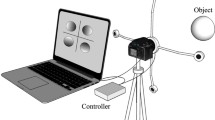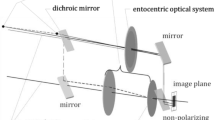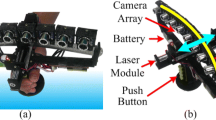Abstract
This paper introduces a simple three-dimensional (3D) stereoscopic method using a single unit of an imaging device consisting of a charge-coupled device (CCD) and a zoom lens. Unlike conventional stereoscopy, which requires a pair of imaging devices, 3D surface imaging is achieved by 3D image reconstruction of two images obtained from two different camera positions by scanning. The experiments were performed by obtaining two images of the measurement target in two different ways: (1) by moving the object while the imaging device is stationary, and (2) by moving the imaging device while the object is stationary. Conventional stereoscopy is limited by disparity errors in 3D image reconstruction because a pair of imaging devices is not ideally identical and alignment errors are always present in the imaging system setup. The proposed method significantly reduced the disparity error in 3D image reconstruction, and the calibration process of the imaging system became simple and convenient. The proposed imaging system showed a disparity error of 0.26 in the camera pixel.















Similar content being viewed by others
Data availability
The data that supports the findings of this study are available from the corresponding author upon reasonable request.
References
Varda, K., Zaimović-Uzunović, N., Softić, A., & Bešlagić, E. Dimensional and Shape Control of the Part Using Cmm and 3d Scanner. Available at SSRN 4298597.
Ito S, Tsutsumi D, Kamiya K, Matsumoto K, Kawasegi N (2020) Measurement of form error of a probe tip ball for coordinate measuring machine (CMM) using a rotating reference sphere. Precis Eng 61:41–47
Fan KC, Li RJ, Xu P (2019) Design and verification of micro/nano-probes for coordinate measuring machines. Nanomanuf Metrol 2(1):1–15
Li S, Zeng L, Feng P, Yu D (2020) An accurate probe pre-travel error compensation model for five-axis on-machine inspection system. Precis Eng 62:256–264
Edmondson V, Woodward J, Lim M, Kane M, Martin J, Shyha I (2019) Improved non-contact 3D field and processing techniques to achieve macrotexture characterization of pavements. Constr Build Mater 227:116693
Virtanen JP, Daniel S, Turppa T, Zhu L, Julin A, Hyyppä H, Hyyppä J (2020) Interactive dense point clouds in a game engine. ISPRS J Photogramm Remote Sens 163:375–389
Lozano A, Hayes JC, Compton LM, Azarnoosh J, Hassanipour F (2020) Determining the thermal characteristics of breast cancer based on high-resolution infrared imaging, 3D breast scans, and magnetic resonance imaging. Sci Rep 10(1):1–14
Kolose S, Stewart T, Hume P, Tomkinson GR (2021) Prediction of military combat clothing size using decision trees and 3D body scan data. Appl Ergon 95:103435
Huang C, Wang G, Song H, Li R, Zhang H (2022) Rapid surface defects detection in wire and arc additive manufacturing based on laser profilometer. Measurement 189:110503
Cui B, Tao W, Zhao H (2021) High-precision 3d reconstruction for small-to-medium-sized objects utilizing line-structured light scanning: A review. Remote Sens 13(21):4457
Yang SP, Seo YH, Kim JB, Kim H, Jeong KH (2019) Optical MEMS devices for compact 3D surface imaging cameras. Micro Nano Syst Lett 7:1–9
Song Z, Song Z, Zhao J, Gu F (2020) Micrometer-level 3D measurement techniques in complex scenes based on stripe-structured light and photometric stereo. Opt Express 28(22):32978–33001
Li C, Yu L, Fei S (2019) Real-time 3D motion tracking and reconstruction system using camera and IMU sensors. IEEE Sens J 19(15):6460–6466
Lee CB, Guo X (2022) Spatially Resolved Stereoscopic Surface Profiling by using a Feature-Selective Segmentation and Merging Technique. Surf Topogr: Metrol Prop 10:014002
Xiangyu Guo and ChaBum Lee (2022) Fluorescence Strobo-Stereoscopy for Specular Reflection-Suppressed Full Field of View Imaging. Measurement 192:11090
Guo X, Lee CB (2021) Preliminary study of phase-shifting strobo-stereoscopy for cutting tool monitoring. J Manuf Process 64:1214–1222
He K, Sui C, Lyu C, Wang Z, Liu Y (2020) 3D reconstruction of objects with occlusion and surface reflection using a dual monocular structured light system. Appl Opt 59(29):9259–9271
Lyu C, Li P, Wang D, Yang S, Lai Y, Sui C (2020) High-speed optical 3D measurement sensor for industrial application. IEEE Sens J 21(10):11253–11261
Ye J, Zhou C (2021) Time-resolved coded structured light for 3D measurement. Microw Opt Technol Lett 63(1):5–12
Bao Y, Tang L, Srinivasan S, Schnable PS (2019) Field-based architectural traits characterisation of maize plant using time-of-flight 3D imaging. Biosyst Eng 178:86–101
Altuntas C (2021) Triangulation and time-of-flight based 3D digitisation techniques of cultural heritage structures. Int Arch Photogramm Remote Sens Spat Inf Sci 43:825–830
Jiang Y, Karpf S, Jalali B (2020) Time-stretch LiDAR as a spectrally scanned time-of-flight ranging camera. Nat Photonics 14(1):14–18
Pahl T, Hagemeier S, Künne M, Yang D, Lehmann P (2020) 3D modeling of coherence scanning interferometry on 2D surfaces using FEM. Opt Express 28(26):39807–39826
Wu Y, Luo Y, Chaudhari G, Rivenson Y, Calis A, de Haan K, Ozcan A (2019) Bright-field holography: cross-modality deep learning enables snapshot 3D imaging with bright-field contrast using a single hologram. Light: Sci Appl 8(1):25
Henseler H, Khambay BS, Bowman A, Smith J, Siebert JP, Oehler S et al (2011) Investigation into accuracy and reproducibility of a 3D breast imaging system using multiple stereo cameras. J Plast Reconstr Aesthet Surg 64(5):577–582
Cadena C, Gálvez-López D, Ramos F, Tardós JD, Neira J (2010) Robust place recognition with stereo cameras. In: 2010 IEEE/RSJ International Conference on Intelligent Robots and Systems. IEEE, pp 5182–5189
Yang S, Gao Y, Liu Z, Zhang G (2020) A calibration method for binocular stereo vision sensor with short-baseline based on 3D flexible control field. Opt Lasers Eng 124:105817
Kim BH, Khan D, Choi W, Kim MY (2019) Real-time counter-UAV system for long distance small drones using double pan-tilt scan laser radar. In: Laser radar technology and applications XXIV, vol 11005. SPIE, pp 80–86
Rapp J, Tachella J, Altmann Y, McLaughlin S, Goyal VK (2020) Advances in single-photon lidar for autonomous vehicles: Working principles, challenges, and recent advances. IEEE Signal Process Mag 37(4):62–71
Fan M, Liu Y (2022) Image processing technology based on computer vision algorithm. In: 2022 4th International Conference on Artificial Intelligence and Advanced Manufacturing (AIAM). IEEE, pp 847–850
Burger W (2016) Zhang’s camera calibration algorithm: in-depth tutorial and implementation, vol HGB16-05. University of Applied Sciences Upper Austria, Hagenberg, Austria, pp 1–6
Acknowledgements
The research team thanks Honeywell Federal Manufacturing & Technologies LLC for the project (DE-NA0002839) and National Science Foundation for the project (CMMI #2124999).
Author information
Authors and Affiliations
Contributions
All authors contributed equally to this work.
Corresponding author
Ethics declarations
Disclosures
The authors declare no conflicts of interest.
Additional information
Publisher’s note
Springer Nature remains neutral with regard to jurisdictional claims in published maps and institutional affiliations.
Rights and permissions
Springer Nature or its licensor (e.g. a society or other partner) holds exclusive rights to this article under a publishing agreement with the author(s) or other rightsholder(s); author self-archiving of the accepted manuscript version of this article is solely governed by the terms of such publishing agreement and applicable law.
About this article
Cite this article
Wang, Y., Guo, X., Kim, J. et al. A single camera unit-based three-dimensional surface imaging technique. Int J Adv Manuf Technol 127, 4833–4843 (2023). https://doi.org/10.1007/s00170-023-11866-4
Received:
Accepted:
Published:
Issue Date:
DOI: https://doi.org/10.1007/s00170-023-11866-4




